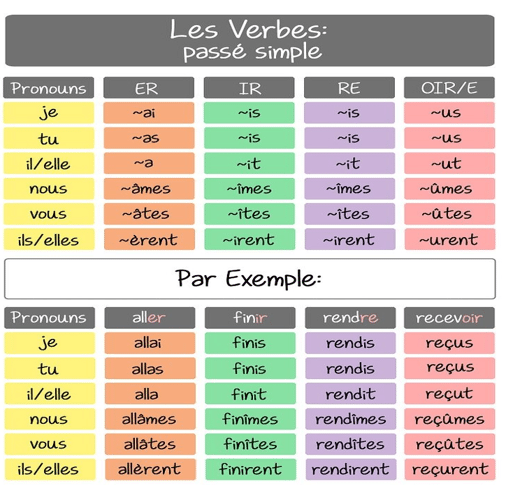French has many past tenses, and the Imparfait and the Passé Composé are its most commonly used everyday by French people. Yet, if you read a book or listen to a play, you will probably hear or see a tense you don’t know about yet: the Passé Simple. What is it and how do you handle it? This is our today’ subject at French Lessons Australia!
When to use it?
The Passé Simple designates a completed action in the past with no relation at all to the present tense. It is what we call a “written” tense, that means that you’re most likely to never have to hear it while you talk to someone, and there is even less possibilities for you to need to use it. The imparfait and the passe composé are really the common past tenses. However, the passé simple is probably the most beautiful (but a bit old-fashioned) French tense, you will find it in books and in classical plays. New books often don’t even use the passé simple anymore. Yet, if you want to be able to read some good classical books such as Les Misérables, spotting the passé simple can be useful. Usually, when you spot a verb looking weird, it is a passe simple!
Difference with the Imparfait and the Passé Composé
The imparfait and the Passe Composé are usually used together, to describe either something that happened far or close from now, or to describe something that happened continuously or for a defined period of time. So when is the passé simple used differently?
The passé simple can be compared to the grand-father of the passé composé as it is its literary equivalent. There are two differences with these tenses. First, one is often used while the other quite never or only in books. Secondly, the passé composé emphasises a clear link with the present and often adds a date or a time, while the passé simple expresses an action that is totally ended.
Finally, while the imparfait is used to set a background or to describe a past context, the passé simple is clearly used to tell about actions that happened over that background. Let’s take an example! You could perhaps read something like this :
- “Ce soir-là, dehors, il pleuvait. Le vent soufflait contre les vitres. Le tonnerre grondait. Pierre lisait son journal au coin du feu. Soudain, on frappa. Pierre se leva et alla ouvrir.
- Translation: ”That night, outside, it was raining. The wind was blowing against the windows. The thunder rumbled. Pierre was reading his newspaper at the fireside. Suddenly, one knocked. Pierre stood up and went opening the door.”
The context is defined by the use of the imparfait (in green) and the passé simple expresses a sudden action (in purple).
How to conjugate the Passé Simple?
As always, we need to refer to the 3 groups -er, -ir, and -re, and to irregular verbs.

-ER verbs are formed by dropping their endings and adding instead the following endings: -ai, -as, -a, -âmes, -âtes, èrent.
Je parlai
Tu parlas
Il parla
Nous parlâmes
Vous parlâtes
Ils parlèrent
-IR and -RE verbs also only keep their stems and add to that the following endings: -is, -is, -it, –îmes, –îtes, -irent.
J’ouvris/appris
Tu ouvris/appris
Il ouvrit/apprit
Nous ouvrîmes/apprîmes
Vous ouvrîtes/apprîtes
Ils ouvrirent/apprirent
Finally, there are two kinds of irregular verbs in the passé simple. The ones building upon their past participles, and the ones that do
not. Fortunately, the first group is the bigger one.
Irregular verbs of the first group are based upon their past participle and add to that the following endings: -s, -s, -t, -^mes, -^tes, -rent.
Je dis
Tu dis
Il dit
Nous dîmes
Vous dîtes
Ils dirent
The passé simple is not a common tense, therefore, you might wonder the objective of this lesson. The passé simple is a pillar of the French language, it is like the Pantheon, the Arc de Triomphe, and all these stunning French buildings: they are not often used for what they are but they are admired and loved for their charm and authenticity. The Passé simple is today perhaps more cultural than really useful everyday, but without it, French would not be French.
If you liked this article and would like to know more about the French language and culture, don’t hesitate to contact us at info@frenchlessons-australia.com.au
See you next time, a bientot!






